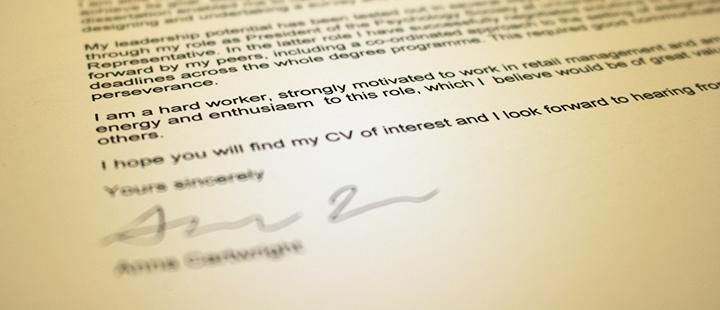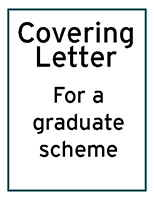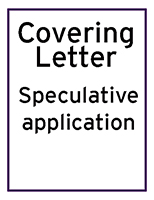Covering letters
A covering letter usually accompanies a CV and can be used for applications by post or online. If an advert asks you to ‘apply in writing’ or ‘send your CV’, you should also send a covering letter.
The purpose of the covering letter is to get the reader to look at your CV by introducing and highlighting some of your key selling points. It is also your opportunity to give more detail about some of the points of your CV. Your letter will form the employer’s opinion of you as a candidate before they have even met you, so make sure it is written to create a positive impression of yourself.
Cover Letter builder
Our Cover Letter Builder is a step-by-step guide that gives examples for each section and offers suggestions for 'power words' to add impact to your application.
You can then download and save, and make any final adjustments in a Word document.
Covering letter guideline
Here are our suggestions on the key sections to help you write and lay out your covering letter. Your letter should be limited to one side of A4 with short paragraphs to make it easy to read. It should be laid out in a professional business style format and if sending with a CV it needs to look like a professional package - your covering letter should have the same style and size of font as your CV, and use the same paper for both.
Dear (Name of person applying to e.g. Ms Berry or Sir or Madam),
RE: JOB TITLE OF ROLE APPLYING FOR (plus Reference number if relevant)
Speculative letters also need a title e.g. ‘CIVIL ENGINEERING PLACEMENT OPPORTUNITIES 2020/21’
Section 1 – who are you and why are you writing?
Clearly state what position you are applying for. Say where and when you saw it advertised, include the details if you have spoken to someone from the organisation about the role (for example at a careers fair) or if it’s a speculative application, describe what type of role you are seeking. Introduce yourself with the degree/course title you are studying/have studied, how it’s relevant to the role applied for, and possibly your classification if graduated.
You can also let them know that your CV is attached for their information.
Section 2* – why you?*
Your opportunity to sell yourself by showing how you have the potential to be an ideal candidate for the role. Using positive and pro-active language, you should address the key requirements of the role by highlighting what relevant skills, qualities, qualifications and work experience you have to offer the organisation. Employers prefer applicants to give specific evidence showing how they have a particular skill. For example, if the advert specifies someone with good influencing skills: “Last summer, I worked for a market research company where on one Saturday, I successfully persuaded over 40 shoppers to stop and answer questions relating to their buying habits, despite their initial reluctance”.
Do not directly repeat what is on your CV but highlight the most interesting points to the employer.
Section 3* – why them?*
Showing that you have a connection to the role and organisation can help your application stand out by giving you a unique selling point. If you have worked at or visited the organisation previously that can be a great starting point, but it could be that they are the industry leader in a field that you are passionate about, or perhaps you particularly relate to the organisation’s mission statement or ethical principles (an organisation’s About Us webpages is usually where you find this info). Concentrate on how your connection will make you a good fit and help you add value to the role, for example: “My passion is for pharmaceutical research and development, in particular in the fight against cancer, and I am hoping to develop my career with your organisation which is at the forefront of innovation in this area”.
Think about what you can do for the organisation rather than benefits to you such as salary, holidays, etc.
Section 4 – finish your letter on a positive note
Suggestions include “I hope you will find my details of interest, however, if you have any queries then please do not hesitate to contact me on the above number. I look forward to hearing from you in the near future.”
Yours sincerely, (if you started with “Dear Name e.g. Ms Berry”) Yours faithfully, (if you started with “Dear Sir or Madam”)
Space for your signature (unless sending electronically; or scan your signature if you wish)
Your name (in full, not initials)
*Sections 2 and 3 can be rearranged as necessary. Use your judgement or ask a career consultant which order makes your application stronger.
Top tips for covering letters
- Send it to a named person. If you are unsure who this should be, phone the organisation and ask – it is much more likely to be read if sent to a specific person.
- Target the letter to the organisation, and explain why – what makes you passionate about working for them specifically?
- Think of your covering letter as a compelling argument to show how you are the best person for the job – remember, the main aim of the covering letter is to get your CV read.
- Keep it to one page only and use the same font and formatting as your CV.
- Reflect the terminology in the job description and person specification in your writing.
- Always proofread thoroughly. A good idea is to read it out loud or to get a friend to read it for spelling and grammar mistakes. You can also book a career appointment with Career and Employability Services to have an adviser look at your letter before you send it off.
- Avoid continual use of “I”. Think about how to phrase your sentences and paragraphs more effectively.
- Your CV and covering letter should work together as a professional package, so use the same style and font size, and use the same paper if you are sending via the post.
- Don’t forget to sign if sending by post.

Sample covering letters
Below are some examples of covering letters used with applications for graduate jobs.
Sample covering letter for an advertised job

If you require this information in an alternative format, please contact our team. You can also read our Website Accessibility Statement.
Sample covering letter for a graduate scheme

If you require this information in an alternative format, please contact our team. You can also read our Website Accessibility Statement.
Sample CL for a speculative application

If you require this information in an alternative format, please contact our team. You can also read our Website Accessibility Statement.
Next steps and further information
- Advice: Once you have a draft copy of your covering letter, we recommend you come in to see one of our career consultants who will look through your letter and make suggestions for improvement. See the career centre appointment availability and reserve an appointment online.
- Workshops: Our regular workshop programme covers a wide range of job-seeking and careers-related topics including CVs and covering letters.
- Our employability skills pages feature information on the skills recruiters are looking for, with examples and advice about how to show you have them.
- Prospects.ac.uk also has good information on covering letters, including some examples.
